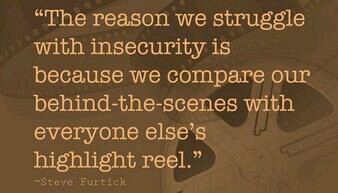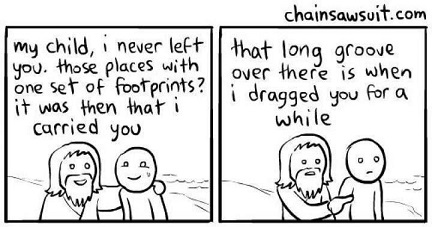 Being in Tulsa, one can’t help but maintain some awareness of the evangelical community and the world of relatively orthodox faith – American Protestant flavor. I’ve been in and out of it myself in years past.
Being in Tulsa, one can’t help but maintain some awareness of the evangelical community and the world of relatively orthodox faith – American Protestant flavor. I’ve been in and out of it myself in years past.
Despite perceptions of the godless and truculent (who seem to find fascist right-wingers ruining fun everywhere), the past few decades have been difficult times for the faithful – especially those in positions of responsibility. It’s increasingly challenging to bring in new, er… ‘believers’. It’s almost as tricky to hang on to those brought up IN the church.
Spiritual ramifications aside, it’s an interesting dilemma. How can organizations – like, say… churches or schools – built on specific beliefs and value systems, with long traditions regarding how things are done, survive (or maybe even grow) as the culture around them loses interest and moves on?
The current system of simply stealing members back and forth across town from one another is inherently flawed and finite. You can imagine the hand-wringing by well-intentioned church leaders and their supporters as they grapple with a question familiar to anyone interested in public education:
How do we adapt to new freedoms, more tantalizing distractions, a new sort of clientele, and a changing set of socio-political realities, without forsaking our core values and beliefs?
This leads to an even more difficult question for either world – church or school…
And what exactly ARE our core values and beliefs? What is it we’re trying to accomplish?

The answers aren’t as self-evident as they may at first seem. In the world of faith, perhaps the goal is to ‘save souls’ – to help people find Jesus or some variation thereof. But that hardly explains multiple meetings each week (composed almost entirely of those already converted) to teach doctrine, or inspire behavior, or correct poorly chosen paths. We must be trying to teach and grow those already converted as well.
Then there are those cell groups and potluck lunches and innumerable breakfast-at-Panera meetings – what do THOSE accomplish? It appears there’s a network or support system of relationships that we value deeply, in addition to our other goals. Fair enough.
Oh – and most churches worth their salt (see what I did there?) have some means of feeding the hungry, clothing the naked, etc. Some target the divorced, victims of abuse, illnesses overseas, or other groups perceived to be in need. There are even a few doing impressive work helping kids succeed in school. Because education ‘breaks the cycle.’
I appreciate them lending depth to my analogy.
These things need not be mutually exclusive, but any organization can only have just so many top priorities – so many ‘primary functions’.
 What does ‘improvement’ look like, exactly? It might be possible to make Sunday mornings more entertaining, for example… does that require a trade-off involving doctrine or appropriate mindsets towards an omnipotent God? Maybe we could focus more on outreach and bringing in the lonely and dysfunctional. That certainly seems in keeping with the overall mission, but what do constant new names and their weird issues do to that community the rest of us need so badly?
What does ‘improvement’ look like, exactly? It might be possible to make Sunday mornings more entertaining, for example… does that require a trade-off involving doctrine or appropriate mindsets towards an omnipotent God? Maybe we could focus more on outreach and bringing in the lonely and dysfunctional. That certainly seems in keeping with the overall mission, but what do constant new names and their weird issues do to that community the rest of us need so badly?
I’ll bet getting rid of hell and so many sins would do wonders for participation – with one minor snag being that if we’re wrong, the fallout could be both permanent and uncomfortable.
And that would be unfortunate.
It’s not my purpose to solve this particular dilemma on behalf of 21st Century Protestantism. I’m not even sure I have a real solution when I transition to the world of public education.
Which is now, I guess.
There’s no shortage of books, blogs, tweets, and edu-rants laying out all the things we supposedly must change/fix/modernize/grow in public education. There are even more about how wrong and awful everyone else’s ideas are. Jonathan Edwards has nothing on BAT or their ilk when it comes to rhetorical venom – just ask them about charters or vouchers or TFA and watch them go! And just smile politely in the direction of Common Core on Twitter to experience a level of scathe beyond all but the most radical evangelicals tackling the most colorful sins.
We do not lack solutions. Everyone has a plan, a direction, a technology, an approach to set things right. Now if we could only agree on what ‘right’ looks like, exactly. What ARE our core values and beliefs? What precisely are we trying to accomplish?
The answers aren’t as self-evident as they may at first seem. Perhaps the goal is ‘college and career readiness’ or some variation thereof. But that hardly explains the variety of subjects we require of even those committed to technical trades or our inflexibility regarding seat time no matter what their gifts or interests. We insist on a diet of literature, science, math, and some social studies, so… we must be trying to enrich and grow those already employable as well.

Then there are those sports, bands, school clubs, and innumerable pep assemblies and speakers – what do THOSE accomplish? It appears there are diverse talents and relationships we care about deeply as well. Fair enough.
Oh – and most schools have some system in place to care for and instruct high-needs kids, those with a wide variety of learning or emotional issues. Many of them aren’t college or career-bound, but we’re nonetheless legally and ethically committed to pour ourselves into those in the greatest need.
There are even a few doing impressive work with character-building and personal responsibility. However carefully we shy away from anything smacking of religion, we not only want our kids to be ‘successful’, we have a non-neutral approach to the morality of how they get there. We’re consciously inculcating ‘rights’ and ‘wrongs’ as we currently define them. Because ‘character counts’.
These things need not be mutually exclusive, but any organization can only have just so many top priorities – so many ‘primary functions’.
 What does improvement even look like, exactly? It might be possible to raise test scores, for example… does that require a trade-off involving personal fulfillment or student attitudes towards learning or the miraculous possibilities it offers? Maybe we could focus more on creative ways to reach the misfits and the underachieving. That certainly seems in keeping with the overall mission, but what does pouring all of our resources into the most draining minority of our population do to the standards and expectations the rest of them need held firmly in order to flourish?
What does improvement even look like, exactly? It might be possible to raise test scores, for example… does that require a trade-off involving personal fulfillment or student attitudes towards learning or the miraculous possibilities it offers? Maybe we could focus more on creative ways to reach the misfits and the underachieving. That certainly seems in keeping with the overall mission, but what does pouring all of our resources into the most draining minority of our population do to the standards and expectations the rest of them need held firmly in order to flourish?
I’ll bet getting rid of grades and so much outdated curriculum would do wonders for participation – with one minor snag being that if we’re wrong, the fallout could be both permanent and uncomfortable.
I have no doubt we can find amazing solutions. We may even manage to scrounge up the resources to implement them. But first, perhaps, we should revisit one more time exactly what our core doctrines and non-negotiables ARE in public education.
What is it that all else must serve?
Unlike in matters of faith, there’s no omniscient power potentially judging us if we get it wrong. The consequences, however, of chasing the wrong sorts of solutions – of forsaking the essential in favor of the flashy, or of clinging to the familiar at the expense of the necessary – well…
That would be unfortunate.
RELATED POST: What Are We FOR?
RELATED POST: All I Need Is This Lamp…

 I considered breaking this post into two parts – the first full of disclaimers regarding my lack of standing to officially throw around terms like “AP” or “Pre-AP”, and the second to say whatever it is I’m about to say.
I considered breaking this post into two parts – the first full of disclaimers regarding my lack of standing to officially throw around terms like “AP” or “Pre-AP”, and the second to say whatever it is I’m about to say. See, in my part of the country, you commonly find Pre-AP classes offered in core subjects as early as 6th or 7th grade. They fade when actual AP classes become an option, generally around 10th grade. These Pre-AP classes logistically replace ‘Honors’ or ‘Gifted & Talented’, but the goals and strategies are substantially different. Or, at least… they should be.
See, in my part of the country, you commonly find Pre-AP classes offered in core subjects as early as 6th or 7th grade. They fade when actual AP classes become an option, generally around 10th grade. These Pre-AP classes logistically replace ‘Honors’ or ‘Gifted & Talented’, but the goals and strategies are substantially different. Or, at least… they should be.  I can’t think of anything more horrifying than going into a brand new year with new students and pre-labeling them based on choices they made with an entirely different teacher a full 8% of their lifetime ago.
I can’t think of anything more horrifying than going into a brand new year with new students and pre-labeling them based on choices they made with an entirely different teacher a full 8% of their lifetime ago. I certainly understand how difficult it is to lead a class through an advanced curriculum and facilitate higher level thinking skills when some members of that class lack the knowledge, know-how, or mindset to follow along. Since time immemorial, teachers have been fighting the sand trap of ‘teaching to the middle’ – losing the low, boring the high, dragging half the middle bravely towards adequacy.
I certainly understand how difficult it is to lead a class through an advanced curriculum and facilitate higher level thinking skills when some members of that class lack the knowledge, know-how, or mindset to follow along. Since time immemorial, teachers have been fighting the sand trap of ‘teaching to the middle’ – losing the low, boring the high, dragging half the middle bravely towards adequacy.  OMG, this new 9th grader isn’t a good student? He’s not READY for advanced coursework? He’s not any GOOD at playing school? He’s immature, or ignorant, or annoying?
OMG, this new 9th grader isn’t a good student? He’s not READY for advanced coursework? He’s not any GOOD at playing school? He’s immature, or ignorant, or annoying?
 Pre-AP is a chance to find that spark, to focus on it and stir it up, in kids who may not understand what it means to play ‘smart.’ It’s an excuse to set aside some of the state standards over trout fishing and Reba McEntire to instead push our little darlings to think, and to ask questions, and to wrestle with point-of-view or how to write an effective argument.
Pre-AP is a chance to find that spark, to focus on it and stir it up, in kids who may not understand what it means to play ‘smart.’ It’s an excuse to set aside some of the state standards over trout fishing and Reba McEntire to instead push our little darlings to think, and to ask questions, and to wrestle with point-of-view or how to write an effective argument.  Or, we can see every kid in front of us, in whatever level of class, as having possibility. If discipline becomes an issue, deal with discipline. If prior coursework is essential, work it out. And if they’re just hopelessly stupid, well… that may prove tricky.
Or, we can see every kid in front of us, in whatever level of class, as having possibility. If discipline becomes an issue, deal with discipline. If prior coursework is essential, work it out. And if they’re just hopelessly stupid, well… that may prove tricky. 
 In keeping with their love of all things dainty, the French introduced the metal frame, lighter and sturdier. Unfortunately, the large wooden wheels and lack of any sort of shock-absorbing mechanism led to another unflattering moniker: the “bone-shaker” – less foppish than ‘dandy-horse,’ but still unlikely to facilitate worldwide acceptance and marketability.
In keeping with their love of all things dainty, the French introduced the metal frame, lighter and sturdier. Unfortunately, the large wooden wheels and lack of any sort of shock-absorbing mechanism led to another unflattering moniker: the “bone-shaker” – less foppish than ‘dandy-horse,’ but still unlikely to facilitate worldwide acceptance and marketability. The ‘Safety Bicycle’ allowed an even greater top speed than the ‘Ordinary’. More importantly, it suddenly made the bicycle easy to ride, fairly safe to steer, easier to control, lighter, and – as production increased to accommodate the wider customer base – less expensive than anything comparable prior.
The ‘Safety Bicycle’ allowed an even greater top speed than the ‘Ordinary’. More importantly, it suddenly made the bicycle easy to ride, fairly safe to steer, easier to control, lighter, and – as production increased to accommodate the wider customer base – less expensive than anything comparable prior.  There are bicycles to suit pretty much any type of rider today – any gender, race, nationality, or income level – but by and large they’re all traceable back to that first ‘Safety’. I suppose we should pay appropriate homage to its ancestors as well – but many are rather awkward to consider.
There are bicycles to suit pretty much any type of rider today – any gender, race, nationality, or income level – but by and large they’re all traceable back to that first ‘Safety’. I suppose we should pay appropriate homage to its ancestors as well – but many are rather awkward to consider.  Suddenly something of great potential but limited use, realistic only for a few, became accessible. The experience reached for by a select minority in prior generations was suddenly not only possible, but intoxicating. It was fun. It was freeing. And it was so good for you – body, mind, and soul.
Suddenly something of great potential but limited use, realistic only for a few, became accessible. The experience reached for by a select minority in prior generations was suddenly not only possible, but intoxicating. It was fun. It was freeing. And it was so good for you – body, mind, and soul.

 One. You have GOT to BREATHE.
One. You have GOT to BREATHE. Two. You’re not stupid.
Two. You’re not stupid. Director’s Cut: Feeling stupid usually indicates you’re not.
Director’s Cut: Feeling stupid usually indicates you’re not.
 Four. Shut yourself up.
Four. Shut yourself up.  Five. Get a planner or agenda of some sort.
Five. Get a planner or agenda of some sort. Six. Choose a few things that won’t take long, do them, and cross them off.
Six. Choose a few things that won’t take long, do them, and cross them off. Seven. When you’re doing a thing, do that thing.
Seven. When you’re doing a thing, do that thing. Eight. When you’re working, work.
Eight. When you’re working, work.
 Ten. Do the parts you can do.
Ten. Do the parts you can do. 